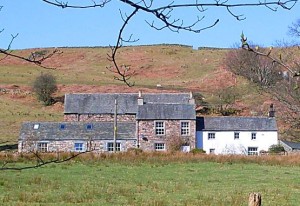Shundraw
Susan Hope reveals some of the history of her family home at
Shundraw
The
present buildings that make up Shundraw Farm were built over the last
four centuries, the oldest part being constructed in 1712, during Queen
Anne’s reign. In 1868, Daniel Bird Robinson built the sandstone part of
the house and the fine example of a bank barn. In 2004 a single storey
extension was added which is faced in local stone primarily from the
quarry behind Shundraw including pink rhyolite from the Armboth dyke.
There
has been a dwelling on the site since, at the very least, Viking times
and probably before. It is thought that originally the Norse
built along the edge of the hills up from the valley bottom and
Shundraw is certainly situated in this position. The name Shundraw is
said to be derived from the Old Norse meaning Look-Out Stead. Although
it is Shundraw now, it has been variously Shonderhowe, Shundra Howe,
Shinderhowe, Shunderhowe and even Shoulderhowe before finally ending in
its present form.

Shundraw
There exists an old bundle of deeds going back to 1624; at this time the name was spelt as “Shundra – how”. There are a few gaps in the deeds but from the documents that we do have, we see that from around 1696 (possibly before, as that Indenture is missing) to 1868 Shundraw was owned by the Harriman family. The first Harriman was a blacksmith and did live on the farm but future Harriman owners (including a master mariner and an Ensign in the 21st Fusiliers) leased the farm to tenants. In 1868 a Daniel Bird Robinson bought Shundraw and made considerable improvements to the dwelling and out buildings.
In 1920 Joseph Harrison moved his family from Burns and farmed there until he retired when his eldest son Sydney took over. Tragically Sydney was killed in a motorbike accident at the wide corner where the road joins the Yew Tree/church road. A fly flew in behind his glasses causing him to swerve. The Harrisons also had three daughters, Rebecca Annie, who was a teacher and died young, Tamar, who married John Jackson and farmed at Hill Top, and Margaret (Madge) who married Thomas Bennett of Moorend, Troutbeck, as well as a younger son, Charles. Charles moved from Lowthwaite to Shundraw after Sydney’s death.
Charles and his wife Hilda (nee Bennett) brought up their 2 daughters, Peggy and Frances. Peggy is still there! Charlie was a farmer of the old school and kept a well-managed neat and tidy farm. Peggy married Ronnie Harrison (no relation) and Susan was the surviving child of three. Now Peggy's grandson and family live in the extension,thus making 6 generations of the family at the farm. Over the years Shundraw has welcomed hundreds of visitors and every summer some return to see if Peggy is still there. During the war the 1868 end of the house was home to a family of evacuees – the only survivor keeps in touch! Former hired ‘lads’ and maids visited regularly, one ‘lad’ in particular telling us that this was the only place that he worked where he was treated like a human being-a sad reflection on past times. It seems to have been a special place for many people and has been the subject of both poetry and paintings.
Susan Hope (Nee Harrison)